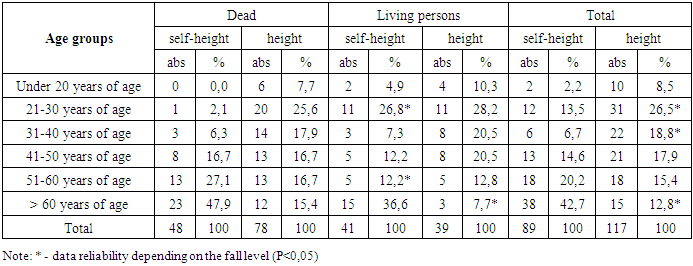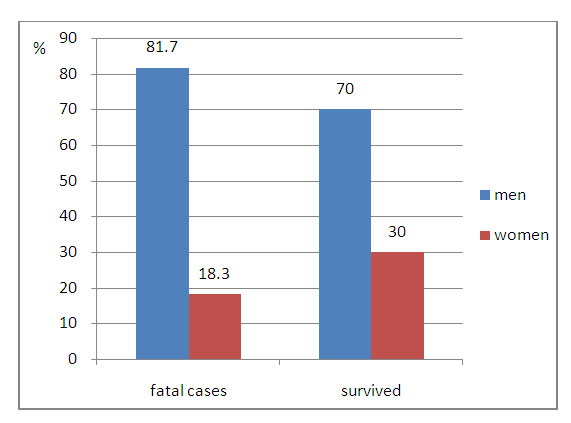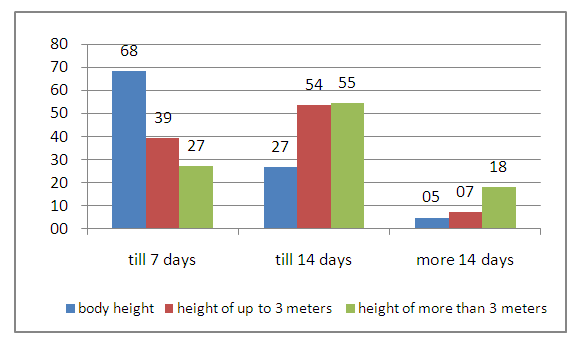N. M. Burankulova1, O. I. Khvan2
1Tashkent Pediatric Medical Institute, Tashkent, Uzbekistan
2Republican Scientific and Practical Center of Forensic Medical Expertise of the Ministry of Health of the Republic of Uzbekistan
Correspondence to: N. M. Burankulova, Tashkent Pediatric Medical Institute, Tashkent, Uzbekistan.
| Email: |  |
Copyright © 2020 The Author(s). Published by Scientific & Academic Publishing.
This work is licensed under the Creative Commons Attribution International License (CC BY).
http://creativecommons.org/licenses/by/4.0/

Abstract
The forensic medical assessment of injuries resulting from a fall from a height and one's own height is not a poorly studied issue either. The aim of the study is to improve the forensic efficiency of differential diagnostics of the injury complex formed as a result of falls from height and body height. Among 80 living persons, medical histories were studied with the establishment of the timing of hospitalization, the presence of surgical intervention and the extent of damage. The injuries were assessed according to the generally accepted method of description during the forensic medical examination. The study took into account alcohol intoxication.
Keywords:
Body height, Injury, Victims, Death, Аorensic еxpertise, Fractures
Cite this paper: N. M. Burankulova, O. I. Khvan, Differential Diagnosis of the Specificity of Fall from Height and Body Height, American Journal of Medicine and Medical Sciences, Vol. 10 No. 10, 2020, pp. 822-825. doi: 10.5923/j.ajmms.20201010.19.
1. Introduction
Forensic evaluation of damage resulting from a fall from height and body height is not a new and less studied issue, but it is one of the most difficult types of forensic expertise, especially in cases of differential diagnostics of damage resulting from a fall from height and body height [1,5,6].In cases of self-height injuries, a comprehensive study is often used, which in some cases is not available for a forensic expert in everyday practice [2,9]. A special significance for forensic examination in case of falling from a height and from body height is revealing the facts of a fall, such as a fall from a shock or a hit [4,7].In most cases, when falling from body height and height, the conditions for an injury are doubtful or unknown, therefore, the forensic expert for the purpose of reconstructing the circumstances of a fall should be provided with the conclusions on the protocol of examination of the scene of the accident, and the injuries discovered during the examination of the corpse, as well as to determine the severity of injuries at living persons [3,8,10].Proceeding from the above mentioned, it seems reasonable to make a study the features of injuries depending on the height of the fall.
2. Materials and Methods
The study is based on a comparative analysis of 206 forensic cases of injuries caused by falls from height and body height in the period from 2016 to 2019 in the Tashkent Branch of the Republican Scientific and Practical Center for Forensic Expertise. The victims were men (150) and women (62) aged 18 to 90 years, most often at the age of 41-60 years (34.0; 70/206).Depending on the aim, the victims were divided into 2 subgroups: falls from height - 117 cases (56.8%) and falls from body height - 89 cases (43.2%). Among all the cases of falls from the height up to 3 meters there were 20.9% and over 3 meters - 35.9%.Among 80 alive persons, which medical documents were studied with establishment of terms of hospitalization, presence of surgical intervention and revealing of volume of damages. Damages were assessed using the generally accepted method of description during the forensic medical expertise. The fact of alcohol intoxication was taken into account in the study.
3. Research Results
Age gradation when falling from height and body height had its own principal features (Table 1). Thus, the highest number of victims of self-height fall is observed in the age group from 51-60 years old and over 60 years old (27.1% and 47.9% respectively), while the highest number of victims of self-height fall is observed in the age group from 21 to 30 years old and from 31 to 40 years old (28.2% and 20.5% respectively).Table 1. The number of victims who died and survived as a result of falling from height and body height
 |
| |
|
There is a reliable age difference between falling from the height and from the body height, both among survived and among fatal cases (P<0,05). When falling from a height and from body height significantly more often prevailed male (P < 0.05) in relation to female sex: 2.4:1. The gender distribution of victims, depending on the outcome of the fall, was not reliable (Fig. 1).  | Figure 1. The analysis of victims according to the type of fall |
Thus, when men fell from height with fatal outcome were found in 74.6% of cases (94/129), and when survived victims fell from body height - 70%. However, it should be noted that women were less often registered as lethal than survived (18.3% against 30% respectively).In 19.4% of cases, the victims had ethyl alcohol in their blood.When falling from the body height among the fatal victims the death occurred in most cases by 6-10 days (25.0%), when falling from the height of up to 3 meters in the first 3 days (33.3%), while when falling from the height of more than 3 meters the mortality rate in 55.5% of cases occurred in place (Fig. 2). | Figure 2. Distribution of fatal victims depending on the time of death after injury |
The length of stay in the hospital among the living victims of the fall from the height and body height also had its regularities, which are presented in Fig. 3. | Figure 3. Distribution of survived according to the period of hospitalization after injury |
As can be seen from the diagram, survived who fell from body height of 58.3% were hospitalized for up to 7 bed days, and only 4.9% for more than 14 days, while when falling from a height of 3 meters and more than 3 meters for up to 14 bed days were hospitalized for 53.6% and 54.5% respectively.Falling from body height, in the group of 89 practical observations, is characterized by the following criteria, so among the victims in 53.9% (48 out of 89) cases died in medical institutions for 1-7 days after the injury, and only in 12.5 cases, the death occurred at the place of injury. In 70.8% of cases the cause of death was a complication of blunt trauma of the head and cervical spine, in 10.4% of cases there were injuries of the thorax in the form of ribs, collarbones, which are not combined with injuries of internal organs. Among 46.1% (41 out of 89) of survived who fell from their own height, it was found that 92.7% of victims had external injuries in the scalp area, while 9.8% had external injuries in the chest area. We would like to especially note the percentage of damage of upper and lower extremities in the form of open and closed fractures. Thus, the survived of the fall from their own height have 7.3% of external injuries of the upper extremities, while in case of lethal outcomes this percentage increases almost 2 times (22.9%; P<0.05), external injuries of the lower extremities were noted in 12.2% of the survived and in 20.8% of cases of lethal outcomes (P<0.05).Falling from the height up to 3 meters in the group of 42 practical observations is characterized by the following criteria, so the victims in 23,8% (10 out of 42) cases died in medical institutions for 1-14 days after the injury, and in 26,7% of cases (4 out of 42), the death occurred at the place of injury. The victims died from the consequences of blunt head trauma (96.7%), less often from the consequences of breast trauma (29.3%) and combined breast and head trauma (12.5%), persons older than 60 died from the consequences of combined breast, abdomen, extremities and combined head, breast, abdomen, and extremities trauma. In 93,7% of fatal victims there were internal injuries in the form of intracranial traumatic hemorrhages combined with single fractures of skull bones (19,2%), signs of internal organs shock (21,5%). In general, equal distribution of isolated and combined traumas has been established. Among the survived (28/42; 66,7%) head traumas have been registered in most cases, and in 23,8% (10/42) open craniocerebral trauma has been established. Brain hemorrhages were reported in 40.5% (17/42) of cases. Internal injuries of the chest, in the form of rib fractures, abdominal injuries are registered.Practical observations of 74 cases when falling over 3 meters are characterized by the following criteria: 47.3% (35 out of 74) of cases died at the place of injury, 20.3% (15 out of 74) of victims died in medical institutions during the first day, 17.6% (13 out of 74) of cases died in the next 20 days of hospitalization. At the age of up to 20 years death occurred from combined trauma of head, cervical spine, chest, lower extremities, pelvis, in age groups 21-60 more often death from consequences of combined trauma of chest, lower extremities, pelvis, less often from consequences of trauma of chest, abdomen, extremities, persons older than 60 years died from complications of combined trauma of head, chest, abdomen, extremities. External injuries were localized mainly in the scalp (42 of 74; 56.6%). Internal injuries were represented in 31.1% (23 out of 74) by intracranial traumatic hemorrhages combined with skull fractures, lower limb fractures - 47.3% (35 out of 74), chest injuries - 47.3% (35 out of 74), abdominal injuries - 20.3% (15 out of 74), pelvic fractures - 18.9% (14 out of 74).Among 11 (14.9%) survived, external injuries were noted in all cases, with 63.6% of them having combinations with chest injuries (18.2%), upper and lower limbs injuries (18.2 and 27.3% respectively). Internal injuries were characterized by open and closed craniocerebral injuries (8.2% and 81.8%, respectively), in 36.4% of cases they were combined with rib fractures, collarbone and scapula (27.3%). Brain hemorrhages were reported in 72.2% of cases.Thus, with an increase in the height of the fall, both the number of injuries and their severity naturally increase, and injuries of internal organs (blunt trauma of abdominal and thoracic areas, ruptures and contusions of the liver, spleen, heart, lungs, kidneys, etc.), internal bleeding and ruptures of organs from anatomical locations are more characteristic. When falling from the body height rarely observed combined injuries with fractures of the upper and lower extremities, chest, pelvic bones and spinal column.
4. Conclusions
1. In order to clarify the height of the victim's fall without external damage, it is advisable to perform a detailed examination of the bone and ligament system at the level of the cervical spine, spinal canal cavity, substances and membranes of the spinal cord.2. In fatal falls from height, combined injuries, closed brain injuries, open brain injuries, contusions of the brain, bleeding into the ventricles and under the membranes of the brain, internal injuries such as blunt abdominal injury, chest with ruptures and contusions of internal organs (liver, spleen, lungs, heart, kidneys, etc.) are more prevalent.3. The above head injuries are found when falling from the body height, but not in combination with internal injuries.4. Identification and determination of differential-diagnostic criteria of injuries by the nature of morphological changes makes it possible to judge not only about the height of the fall, but also about the primary point of impact and the direction of impact against a hard surface.
References
| [1] | Avdeev, A.I. Zhukova, N.Yu. Forensic and medical differential diagnostics of the face and head injuries // Vestnik of forensic medicine. 2019. V. 8. № 1. pp. 4-8. |
| [2] | Akopov V.I. Criminal mortality: distortions and errors of statistics // Meditsinskaia ekspertiza i pravo. 2015. № 1. pp. 10-14. |
| [3] | Akopov V.I. Maslov E.N. Road Traffic Injury or Fall from Height? (On the judicial process in the Kirov district court of Rostov-on-Don) // Medical expertise and law. 2013. № 4. pp. 59-63. |
| [4] | M. Burankulova N.M., Musurmonkulov J.M. Forensic and medical criteria for the evaluation of combined craniocerebral traumas received during a fall from a height and from body height // Postgraduate physician. 2013. V. 57. № 2. pp. 4-8. |
| [5] | Hubler E.V. Computational methods for analysis and recognition of pathological processes. L: Medicine, 1978. 296 p. |
| [6] | Petrova G.V. International Anatomical Terminology with Grammar of Latin Terms. Moscow: Abris, 2019. 368 p. |
| [7] | A. Tenkov A.A., Glinskiy S.V. Differential Diagnostics of Drop Features in the Plane by Regional Damage Affinity (in Russian) // Modern Problems of Science and Education. - – 2020. - – № 4. |
| [8] | Khabova, Z.S.; Smirenin, S.A.; Fetisov, V.A.; Tamberg, D.K. Use of the sequential mathematical analysis for an establishment of a driver's location at traumas inside a car on limb injuries (in Russian) // Forensic medical examination. 2015. V. 58. № 2. pp. 17-21. |
| [9] | Khvan O.I., Abdukarimov B.A. Forensic characteristics of liver, spleen and kidney damage when falling from a height // Journal of Surgery of Uzbekistan. - Tashkent, 2015. - № 1.- pp.56-58. |
| [10] | Khvan O.I. Forensic aspects of the assessment of damage abdominal organs and kidneys in non-fatal automobile/ international scientific peer-reviewed journal "Arts of medicine". USA, East Hanover. 2016. № 2.pp.18-21 (Universal Impact Factor-0,211). |






 Abstract
Abstract Reference
Reference Full-Text PDF
Full-Text PDF Full-text HTML
Full-text HTML